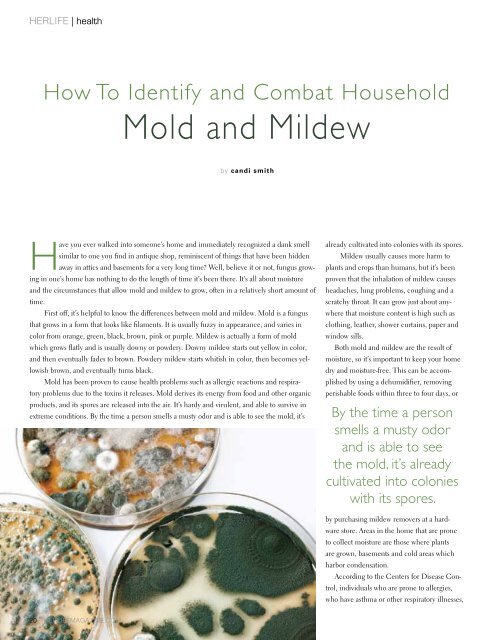1 - HER LIFE Magazine
1 - HER LIFE Magazine
1 - HER LIFE Magazine
You also want an ePaper? Increase the reach of your titles
YUMPU automatically turns print PDFs into web optimized ePapers that Google loves.
herlife | health<br />
How To Identify and Combat Household<br />
Mold and Mildew<br />
by candi smith<br />
Have you ever walked into someone’s home and immediately recognized a dank smell<br />
similar to one you find in antique shop, reminiscent of things that have been hidden<br />
away in attics and basements for a very long time? Well, believe it or not, fungus growing<br />
in one’s home has nothing to do the length of time it’s been there. It’s all about moisture<br />
and the circumstances that allow mold and mildew to grow, often in a relatively short amount of<br />
time.<br />
First off, it’s helpful to know the differences between mold and mildew. Mold is a fungus<br />
that grows in a form that looks like filaments. It is usually fuzzy in appearance, and varies in<br />
color from orange, green, black, brown, pink or purple. Mildew is actually a form of mold<br />
which grows flatly and is usually downy or powdery. Downy mildew starts out yellow in color,<br />
and then eventually fades to brown. Powdery mildew starts whitish in color, then becomes yellowish<br />
brown, and eventually turns black.<br />
Mold has been proven to cause health problems such as allergic reactions and respiratory<br />
problems due to the toxins it releases. Mold derives its energy from food and other organic<br />
products, and its spores are released into the air. It’s hardy and virulent, and able to survive in<br />
extreme conditions. By the time a person smells a musty odor and is able to see the mold, it’s<br />
already cultivated into colonies with its spores.<br />
Mildew usually causes more harm to<br />
plants and crops than humans, but it’s been<br />
proven that the inhalation of mildew causes<br />
headaches, lung problems, coughing and a<br />
scratchy throat. It can grow just about anywhere<br />
that moisture content is high such as<br />
clothing, leather, shower curtains, paper and<br />
window sills.<br />
Both mold and mildew are the result of<br />
moisture, so it’s important to keep your home<br />
dry and moisture-free. This can be accomplished<br />
by using a dehumidifier, removing<br />
perishable foods within three to four days, or<br />
By the time a person<br />
smells a musty odor<br />
and is able to see<br />
the mold, it’s already<br />
cultivated into colonies<br />
with its spores.<br />
by purchasing mildew removers at a hardware<br />
store. Areas in the home that are prone<br />
to collect moisture are those where plants<br />
are grown, basements and cold areas which<br />
harbor condensation.<br />
According to the Centers for Disease Control,<br />
individuals who are prone to allergies,<br />
who have asthma or other respiratory illnesses,<br />
20 <strong>HER</strong><strong>LIFE</strong>MAGAZINE.COM

















